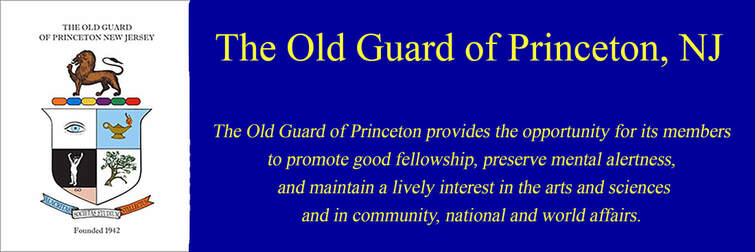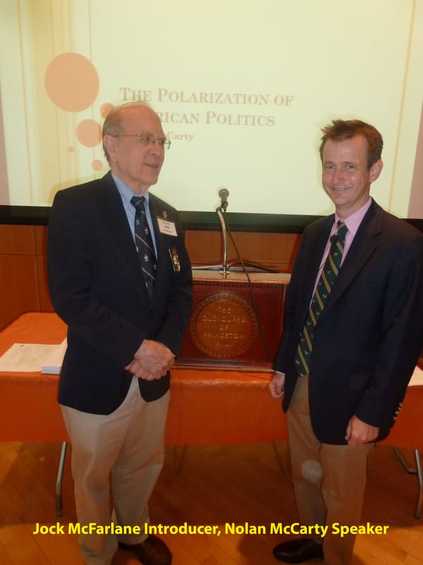September 21, 2011
The Polarization of American Politics
Nolan McCarty
Susan Dod Brown Professor of Politics Public Affairs, Chair, Department of Politics, Princeton University
The Polarization of American Politics
Nolan McCarty
Susan Dod Brown Professor of Politics Public Affairs, Chair, Department of Politics, Princeton University
Minutes of the Second Meeting of the 70th Year
President Bob Varrin called the meeting to order at 10:15.
Tom Fulmer led the invocation.
Minutes of the meeting of September 14 were read by Jock McFarlane.
Jack Reilly the names of twelve candidates for membership in the Old Guard, all of whom were elected unanimously: Charles Ascher, Richard Bergman, Michael Curtis, Aiden Doyle, Helen Hamilton, Alan Hegedus, Allen Kassof, Michael Mathews, Dennis Minely, Hans DeRuyter, David Tierno, Charles Westoff.
Jock McFarlane introduced the speaker, Nolan McCarty, Susan Dod Brown Professor of Politics and Public Affairs, chair of the Politics Department, Princeton University, and coauthor of the book “Polarized America: The Dance of Ideology and Unequal Riches.”
Professor McCarty spoke on the topic of “The Polarization of American Politics,” using data to separate fact from fiction in relation to three questions: Has there been an increase in polarization in American politics? If so, to what is this due? If so, what can be done about it?
First question: Has there been an increase in polarization in American politics? Answer: Yes. Although American politics has always been contentious, with Democrats and Republicans standing for different things, today polarization is strikingly high. Measuring polarization in Congress from the end of the Civil War to the present in terms of the difference between Democrats and Republicans on a liberal to conservatism scale indicates that polarization was high after the Civil War, lower during the 1950s and 1960s, and on an upward trend since the 1970s. Polarization now rivals that found after the end of the Civil War. In addition, considering congressional votes on matters such as health care, equal employment opportunity, and financial reform, whereas there were small differences between Democrats and Republicans in the 1960s, in the present they are considerable: “There is a change from bipartisan to bipolar.”
Second question:To what is the increased polarization due? Answer: Although some attribute the increase to wedge issues such as abortion, guns, and same sex marriage, it is income inequality that is the driving force between the parties. Plotting a polarization index in the House of Representatives shows that it follows the path of increases in income inequality; that is, there is a high correlation between income inequality and polarization as measured by voting patterns in congress. In addition, data indicate that during periods of low income inequality (e.g., during the 1950s and 1960s), high and low income people were equally likely to vote for each party, whereas in periods of high income inequality (e.g., during the 2000s), high income people are much more likely, in fact three times more likely, to vote Republican. Finally, considering voting patterns within states, high income voters vote Republican, particularly in Red states, whereas low income people vote Democratic. In sum, people vote by economic self-interest and voting behavior reflects polarization on issues relevant to the economy.
Third Question: What can be done about the polarization? Answer: Periods of low polarization may not be the norm in American politics and small fixes to the political system (e.g., changes in the electoral system, less gerrymandering of congressional districts, open as opposed to closed primaries, campaign finance reform) will not make the problem of polarization go away: “The problem is not how we get back to 1955 but how do we manage our politics going forward.”
A number of interesting points were made in relation to questions from members of the Old Guard. What about the role of independents? There does not appear to be a real increase in the number of independents. Those who declare themselves to be independent but leaning in one or another direction tend to vote in the same way as those committed to one or another party. What about the role of the media? Polarization makes for good tv and often the media focuses on wedge issues. Whereas during the ‘60s and ‘70s people relied upon the three major networks for their news, and these networks were relatively nonpartisan, today people can watch channels slanted toward their political point of view. One study found that when Republicans, Liberals, and Moderates were given the choice of watching Fox News, CNN, or Seinfeld reruns, Republicans chose to watch Fox News, Liberals to watch CNN, and Moderates to watch Seinfeld reruns. What about the role of lobbyists? “Although there has been an increase in the number of lobbyists since the 1970s, polarization probably has had a bigger impact on lobbying that vice versa.” Is polarization necessarily a bad thing? It probably has some good things associated with it (e.g., it is easier to know what the parties stand for, it is easier to hold them accountable, it may increase engagement), but at some point the costs outstrip the benefits: “We now are at the point where instead of seeking to find common ground, politicians fight for principles regardless of the consequences for the country.”
Respectfully submitted,
Larry Pervin
Tom Fulmer led the invocation.
Minutes of the meeting of September 14 were read by Jock McFarlane.
Jack Reilly the names of twelve candidates for membership in the Old Guard, all of whom were elected unanimously: Charles Ascher, Richard Bergman, Michael Curtis, Aiden Doyle, Helen Hamilton, Alan Hegedus, Allen Kassof, Michael Mathews, Dennis Minely, Hans DeRuyter, David Tierno, Charles Westoff.
Jock McFarlane introduced the speaker, Nolan McCarty, Susan Dod Brown Professor of Politics and Public Affairs, chair of the Politics Department, Princeton University, and coauthor of the book “Polarized America: The Dance of Ideology and Unequal Riches.”
Professor McCarty spoke on the topic of “The Polarization of American Politics,” using data to separate fact from fiction in relation to three questions: Has there been an increase in polarization in American politics? If so, to what is this due? If so, what can be done about it?
First question: Has there been an increase in polarization in American politics? Answer: Yes. Although American politics has always been contentious, with Democrats and Republicans standing for different things, today polarization is strikingly high. Measuring polarization in Congress from the end of the Civil War to the present in terms of the difference between Democrats and Republicans on a liberal to conservatism scale indicates that polarization was high after the Civil War, lower during the 1950s and 1960s, and on an upward trend since the 1970s. Polarization now rivals that found after the end of the Civil War. In addition, considering congressional votes on matters such as health care, equal employment opportunity, and financial reform, whereas there were small differences between Democrats and Republicans in the 1960s, in the present they are considerable: “There is a change from bipartisan to bipolar.”
Second question:To what is the increased polarization due? Answer: Although some attribute the increase to wedge issues such as abortion, guns, and same sex marriage, it is income inequality that is the driving force between the parties. Plotting a polarization index in the House of Representatives shows that it follows the path of increases in income inequality; that is, there is a high correlation between income inequality and polarization as measured by voting patterns in congress. In addition, data indicate that during periods of low income inequality (e.g., during the 1950s and 1960s), high and low income people were equally likely to vote for each party, whereas in periods of high income inequality (e.g., during the 2000s), high income people are much more likely, in fact three times more likely, to vote Republican. Finally, considering voting patterns within states, high income voters vote Republican, particularly in Red states, whereas low income people vote Democratic. In sum, people vote by economic self-interest and voting behavior reflects polarization on issues relevant to the economy.
Third Question: What can be done about the polarization? Answer: Periods of low polarization may not be the norm in American politics and small fixes to the political system (e.g., changes in the electoral system, less gerrymandering of congressional districts, open as opposed to closed primaries, campaign finance reform) will not make the problem of polarization go away: “The problem is not how we get back to 1955 but how do we manage our politics going forward.”
A number of interesting points were made in relation to questions from members of the Old Guard. What about the role of independents? There does not appear to be a real increase in the number of independents. Those who declare themselves to be independent but leaning in one or another direction tend to vote in the same way as those committed to one or another party. What about the role of the media? Polarization makes for good tv and often the media focuses on wedge issues. Whereas during the ‘60s and ‘70s people relied upon the three major networks for their news, and these networks were relatively nonpartisan, today people can watch channels slanted toward their political point of view. One study found that when Republicans, Liberals, and Moderates were given the choice of watching Fox News, CNN, or Seinfeld reruns, Republicans chose to watch Fox News, Liberals to watch CNN, and Moderates to watch Seinfeld reruns. What about the role of lobbyists? “Although there has been an increase in the number of lobbyists since the 1970s, polarization probably has had a bigger impact on lobbying that vice versa.” Is polarization necessarily a bad thing? It probably has some good things associated with it (e.g., it is easier to know what the parties stand for, it is easier to hold them accountable, it may increase engagement), but at some point the costs outstrip the benefits: “We now are at the point where instead of seeking to find common ground, politicians fight for principles regardless of the consequences for the country.”
Respectfully submitted,
Larry Pervin

